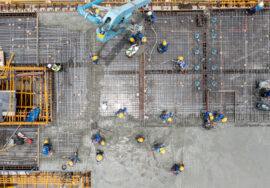
Health and Safety in Construction Project Management
The Importance of Health and Safety in Construction Project Management
Health and safety are critical aspects of construction project management. With construction sites being inherently risky, maintaining proper safety standards not only protects workers but also ensures project efficiency, compliance with regulations, and avoidance of costly delays.
In this article, we’ll explore the importance of health and safety in construction project management and how it impacts the overall success of any construction project.
Protecting Workers and Reducing Accidents
One of the primary reasons for implementing strict health and safety measures in construction is to protect workers. Construction sites often involve working with heavy machinery, hazardous materials, and challenging environments, increasing the potential for accidents. Ensuring the health and safety of workers should be a top priority for project managers.
Regular safety training, proper use of personal protective equipment (PPE), and strict adherence to safety protocols can significantly reduce workplace accidents. This proactive approach not only keeps workers safe but also boosts morale and productivity. Workers who feel protected and cared for are more likely to perform their tasks efficiently and with confidence.
Compliance with Legal Requirements
Construction companies must comply with local, national, and international health and safety regulations. Failure to meet these standards can result in severe penalties, project shutdowns, and legal liabilities. Project managers are responsible for ensuring that their construction sites adhere to all safety regulations set by governing bodies like OSHA (Occupational Safety and Health Administration) or other local authorities.
Regular safety audits and inspections should be conducted to identify potential hazards and ensure that the site complies with safety standards. Keeping up-to-date records of safety protocols, training, and accident reports can also demonstrate compliance and serve as legal protection in case of incidents.
Minimizing Project Delays
Accidents on construction sites can lead to significant project delays. Injuries or fatalities may halt work, resulting in downtime and lost productivity. Moreover, investigations following an accident can further delay the project’s progress, affecting deadlines and increasing costs.
A well-implemented health and safety plan helps minimize the likelihood of accidents, thus reducing the risk of delays. Efficient project management incorporates safety measures that ensure work continues smoothly and within the designated timeframe.
Enhancing Reputation and Client Trust
Companies that prioritize health and safety build a positive reputation in the industry. Clients prefer to work with construction firms that have a track record of maintaining safe working environments. It demonstrates professionalism and responsibility, which can lead to long-term business relationships and repeat contracts.
Additionally, an emphasis on health and safety shows clients that the company is not cutting corners and is focused on delivering a quality project without compromising the well-being of its workforce.
Reducing Costs and Avoiding Fines
Implementing health and safety measures can significantly reduce overall project costs. Preventing accidents means avoiding medical expenses, legal fees, compensation claims, and insurance premium increases. Moreover, adhering to safety regulations prevents costly fines or penalties imposed by authorities.
Investing in safety training, equipment, and procedures upfront can save considerable amounts of money in the long run by avoiding these potential costs.

Safety Culture and Employee Morale
Creating a culture of safety on a construction site improves employee morale. When workers know that their health and well-being are valued, they tend to work more diligently and with fewer distractions. This safety culture should start at the top, with management setting the example and providing the necessary resources for maintaining safety standards.
Encouraging workers to report potential hazards and participate in safety programs also strengthens this culture, ensuring that safety becomes an integral part of the company’s operations.
Technological Advancements in Safety
Technology is revolutionizing health and safety in construction. Wearable devices, drones for site inspection, and real-time monitoring systems allow for more accurate hazard identification and swift response to potential risks. These innovations help project managers stay ahead of safety issues and improve overall site safety management.
For instance, wearable devices can monitor workers’ vitals and environmental conditions, alerting supervisors to dangerous situations before accidents occur. Drones can inspect hard-to-reach areas, reducing the need for workers to expose themselves to risky conditions.
Continuous Safety Improvement
Health and safety measures should not be static. Regular review and updating of safety protocols are essential to adapt to new risks or changing regulations. Continuous improvement ensures that construction projects stay compliant and maintain high safety standards.
Project managers should conduct regular safety meetings, provide ongoing training, and encourage feedback from workers to identify areas for improvement.
Conclusion
Health and safety are essential components of construction project management. Prioritizing the safety of workers, complying with regulations, and minimizing risks not only protect lives but also ensure the smooth progress of construction projects. From reducing delays to enhancing a company’s reputation, a solid health and safety plan is integral to successful project management.
For expert assistance in managing safe construction projects, contact us.
External Links:
- Learn more about OSHA safety standards at OSHA.
- Discover best safety practices in construction at ConstructConnect.
Read more related articles to enhance your knowledge and make informed decisions
10 Essential Steps in the Building Construction Process
How to Choose the Right Materials for Your Construction Project








